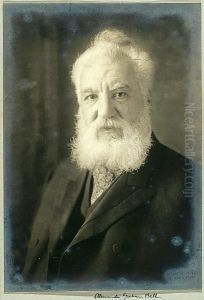Bell Alexander Graham Paintings
Alexander Graham Bell was not an artist in the traditional sense of painters or sculptors, but rather an inventor, scientist, and innovator who left an indelible mark on the world through his contributions to communication technology. Born on March 3, 1847, in Edinburgh, Scotland, Bell's family was deeply involved in the study of elocution and the correction of speech. His father, Alexander Melville Bell, had developed Visible Speech, a written system designed to help the deaf in speaking.
Bell's early life was marked by a fascination with sound and speech, influenced by his work with his father and his mother's gradual deafness. He moved to Canada with his family in 1870 following the deaths of his two brothers from tuberculosis. Shortly thereafter, in 1871, Bell moved to Boston, Massachusetts, in the United States, where he began to teach speech and elocution. He worked closely with the deaf community, including teaching at the Boston School for Deaf Mutes, which later became part of Boston University, where he was appointed Professor of Vocal Physiology.
His work with the deaf led to experiments with electrical signals and the possibility of transmitting speech over wires. Bell's most famous invention, the telephone, was patented in 1876. This revolutionary device transformed communication and earned Bell a place in history. Bell continued to innovate throughout his life, contributing to the development of other technologies including the photophone, which allowed for the transmission of sound on a beam of light, and early iterations of the metal detector and the hydrofoil.
Apart from his scientific endeavors, Bell was also an advocate for the deaf community and a founder of what would become the National Geographic Society. His marriage to Mabel Gardiner Hubbard, who was deaf from an early age, further cemented his lifelong commitment to improving the lives of the deaf.
Alexander Graham Bell passed away on August 2, 1922, at his private estate, Beinn Bhreagh, in Nova Scotia, Canada. His legacy endures in the form of the countless communication devices that trace their origins to his pioneering work. Although not an artist in the traditional sense, Bell's creative genius and his impact on the arts and sciences cement his place as a historical figure of great importance.
